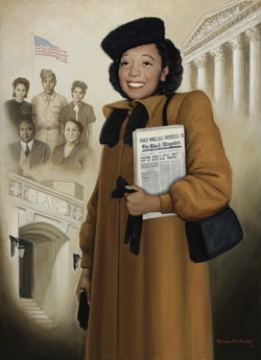End date 1948 | ||
 | ||
Citations 332 U.S. 631 (more)305 U.S. 337; 68 S. Ct. 299;92 L. Ed. 247; 1948 U.S. LEXIS 2645 Prior history Judgment for the State, District Court of Cleveland County, Oklahoma, 199 Okla. 36; affirmed, (Supreme Court of Oklahoma 1946) 180 P.2d 135; Similar McLaurin v Oklahoma State Reg, Sweatt v Painter, Lum v Rice, Missouri ex rel Gaines v Canada, Pace v Alabama | ||
Sipuel v. Board of Regents of Univ. of Okla., 332 U.S. 631 (1948) (per curiam) is a United States Supreme Court case involving racial segregation toward African Americans by the University of Oklahoma's and the application of the Fourteenth Amendment to the United States Constitution.
Contents
Facts
Ada Lois Sipuel (February 8, 1924 – October 18, 1995), born in Chickasha, Oklahoma was the daughter of a minister. Her brother planned to challenge segregationist policies of the University of Oklahoma, but went to Howard University Law School (in Washington, D.C.) in order not to delay his career further by protracted litigation.
Ada Sipuel was willing to delay her legal career in order to challenge segregation. On January 14, 1946, she applied at the University of Oklahoma (at the time, an all-white law school), the only taxpayer funded law school in the State of Oklahoma at the time, and was denied because of race ("color").
She then petitioned District Court of Cleveland County, Oklahoma. Her writ of mandamus was refused. The Oklahoma Supreme Court upheld the decision of the lower district court (in 180 P.2d 135), the petitioners then appealed to the United States Supreme Court.
Findings of the court
Two years later, in 1948, the United States Supreme Court heard the petition on January 7 and 8th, that stated: “petitioner is entitled to secure legal education afforded by a state institution.” They continued that: “The State must provide it for her in conformity with the equal protection clause of the Fourteenth Amendment and provide it as soon as it does for applicants of any other group.” Citing the 1938 case Missouri ex rel. Gaines v. Canada, 305 U.S. 337 (1938), a case in which "Lloyd Gaines, a negro, was refused admission to the School of Law of the University of Missouri".
The petitioners, acting on behalf of Miss Sipuel, were Thurgood Marshall of New York City, and Amos Hall, of Tulsa (also on the brief Frank D. Reeves). The respondents, representing the defendants, the university and the State of Oklahoma, were Fred Hansen, of Oklahoma City, the First Assistant Attorney General of Oklahoma, and Maurice H. Merrill, of Norman (also on the brief Mac Q. Williamson, Attorney General). This was a landmark case in the early civil rights movement. The case reversed Lee v. State of Mississippi, and was also a precursor for Brown v. Board of Education, 347 U.S. 483 (1954).
Only four days after argument, on January 12, the Supreme Court ruled unanimously in favor of Sipuel. The court ruled that the state of Oklahoma must provide instruction for Blacks equal to that of Whites, requiring the admission of qualified black students to previously all-white state law schools, reversing the Supreme Court of Oklahoma decision. In 1950, the Supreme Court again ruled unanimously in Sweatt v. Painter, 339 U.S. 629 (1950) a case in which Herman Marion Sweatt was refused admission to the University of Texas School of Law on the grounds that the Texas State Constitution prohibited integrated education.
Impact
According to Supreme Court Associate Justice John Paul Stevens, who sat in the gallery and watched Marshall argue the case before the court on Thursday, January 8, 1948, Marshall was: “respectful, forceful and persuasive – so persuasive that on the following Monday – only four days after the argument – the Court unanimously ruled in Sipuel's favor.” In addition, Ada Sipuel was: “not only an excellent student, but was welcomed by her classmates who did not agree with the exclusionary policy that the State had unsuccessfully tried to defend.”
A garden, located between Jacobson Hall and Carpenter Hall, on the campus of the University of Oklahoma, now stands in honor of this event.
